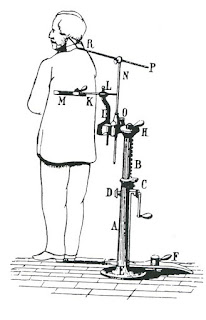Photography using the exposure of light-sensitive materials began around the start of the 19th century.
Exposure times were by necessity long as the materials used were not as sensitive to light as more modern films. This meant that if a photographer was photographing something other than an inanimate object then the subject had to remain still for the whole period of the exposure which may last hours in the early days.
Try sitting perfectly still for 30 seconds. Yep, nose is already itching. So you can imagine how demanding it would have been to sit for hours. To overcome this problem 'posing stands' were used to support the poor subject and enable them to remain relatively still.
As time went on the technology improved and the exposure time was reduced to minutes (and eventually seconds).
Adults may be happy to sit still to have their photos taken but small children were another matter. They like to fidget and move around so you've got no chance of the little darlings sitting still to have their portraits taken. However, the Victorians came up with a simple fix - hide their mother under a sheet behind them to hold them still. The sheet could be made to look like the back of a chair and no-one would notice. Today these are generally known as Hidden Mother photographs.
And not just for babies:
Once you have some new technology some bright spark will find an alternative use for it. The Victorians loved their seances but with so many fake ghosts making an appearance at them some hard evidence for the supernatural was required. By taking multiple exposures on one photographic plate a 'ghost' could be seen to be present. Photoshop for the 1800's.
The ghosts may not have been real dead people but the Victorians had no qualms about photographing real corpses. Poor families could not afford a portrait painter to immortalise their families but some could afford a photographer. If, however, there hadn't been time to have their photograph taken whilst they were still alive their families would have them photographed post-mortem. Memento-mori were quite literally images of dead relatives.
Memento-mori have made a come-back recently but in a much more real form. Some people are now choosing to see their loved one not in a coffin at their funeral but preserved and presented as close to what they were in life.
Racking your brain as to where the title of this post comes from...?
Catch You Later!
Credits:
http://hiddenmotherphotos.tumblr.com/
http://blog.myheritage.com/2013/07/photos-from-the-past-hidden-mothers/
http://www.paranormal360.co.uk/the-best-of-victorian-ghost-photography/
http://mistgates.tumblr.com/post/65616671341/victorian-ghost-photography
http://theghostdiaries.com/memento-mori-victorian-death-photos/
http://klaq.com/halloween-game-which-body-is-the-corpse-in-these-creepy-victorian-photographs/
http://abcnews.go.com/US/dead-people-life-poses-funerals/story?id=23456853
http://www.dailymail.co.uk/news/article-2549870/Deceased-boxer-23-posed-standing-ring-wake.html
https://en.wikipedia.org/wiki/Photography
https://scheong.wordpress.com/2013/01/18/say-cheese-a-history-of-early-photography/
A big thank-you to my friend Siobhan for bringing Hidden Mother photographs to my attention and so prompting me to create this post.
tags:
#photography
#Victorian
#hidden mother
#spiritualism
#seance
#memento mori
#flock of seagulls








